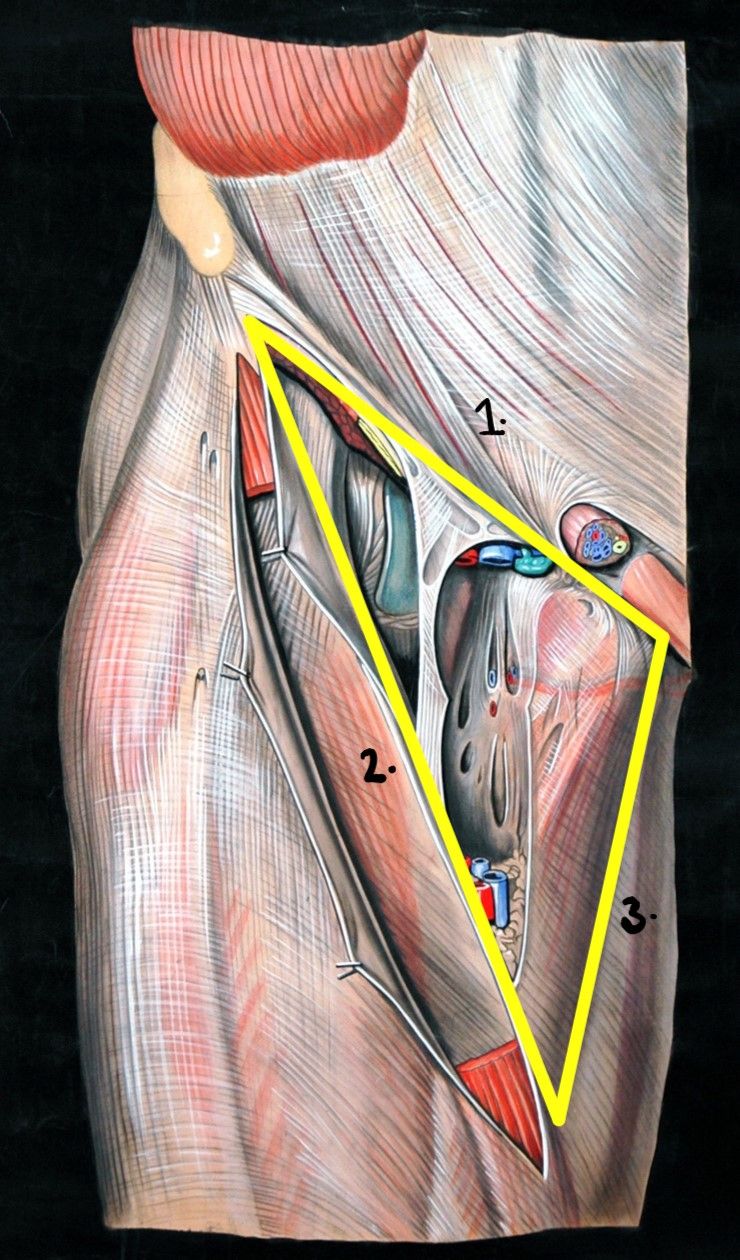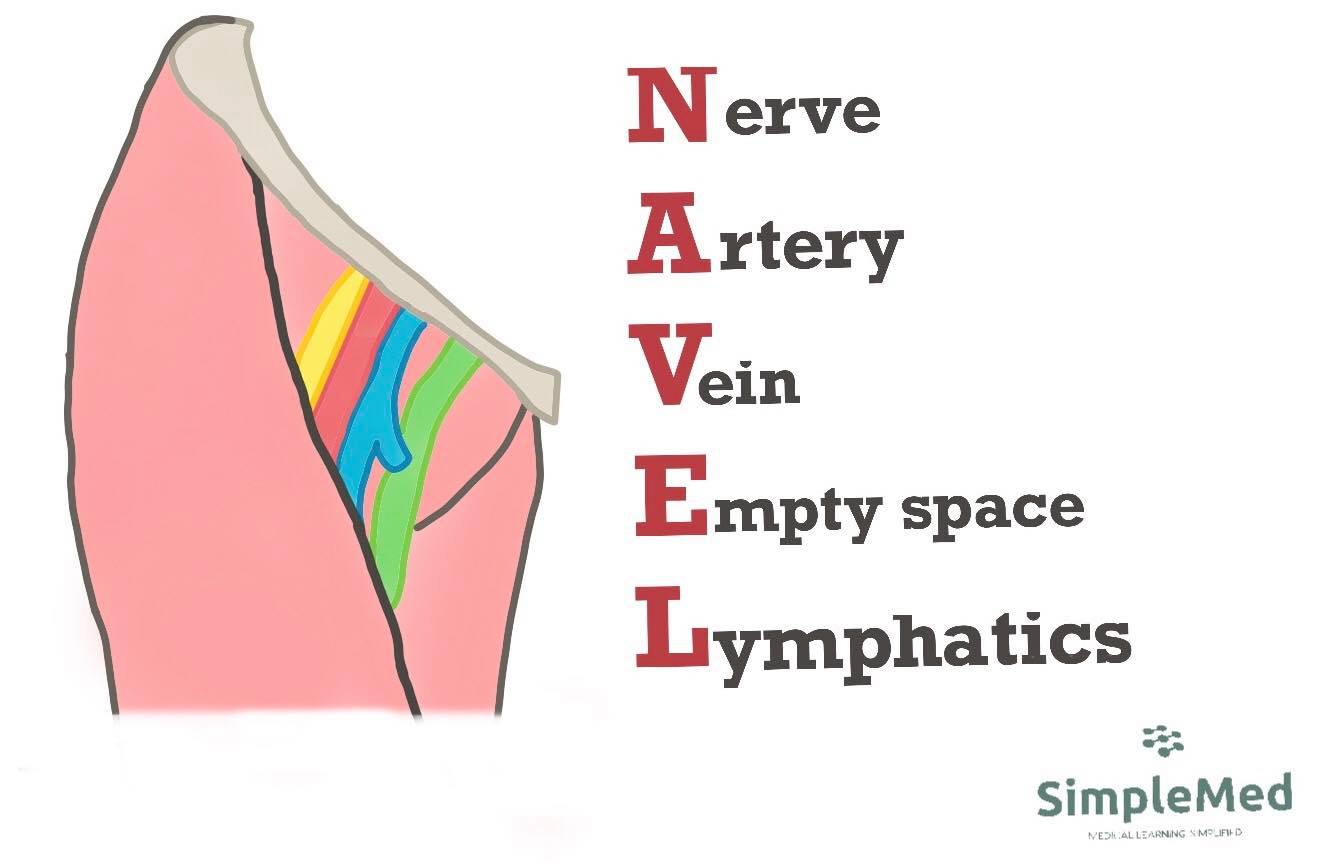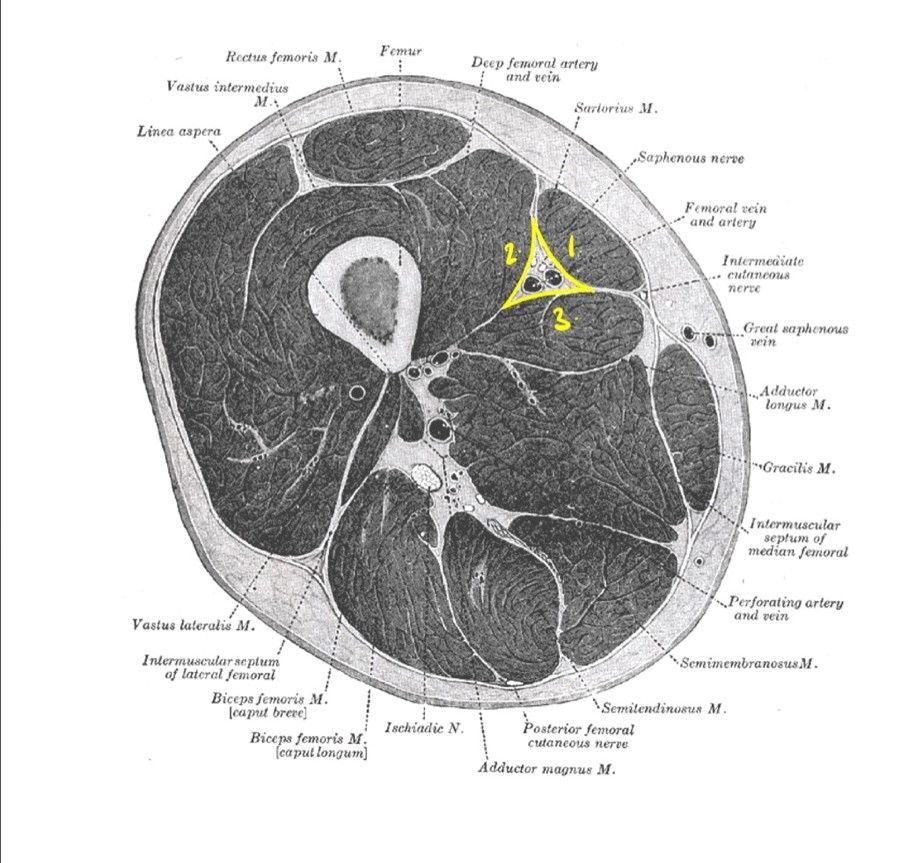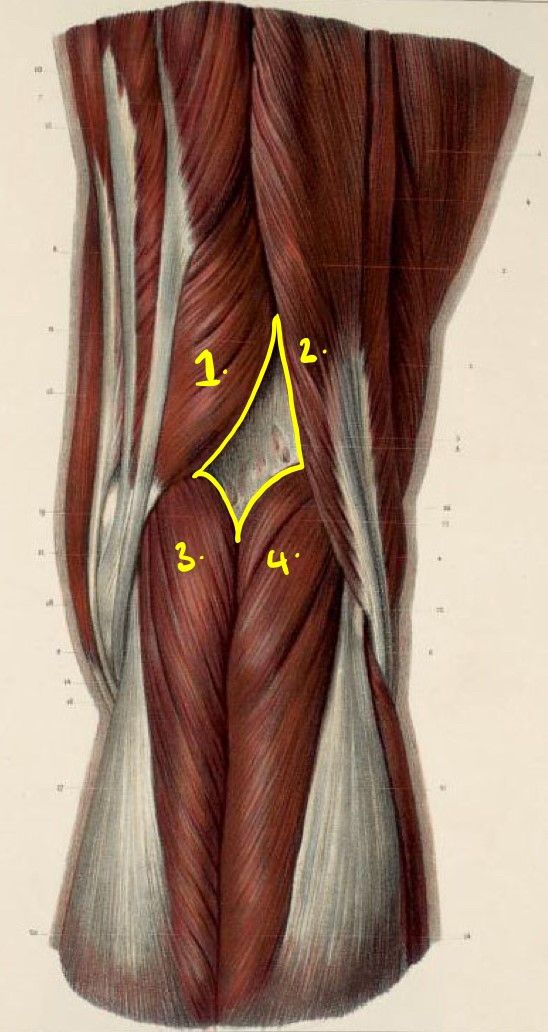Next Lesson - Bones of the Lower Limb
Abstract
There are four key areas within the lower limb:
- The femoral triangle, containing the femoral nerve, artery, vein and femoral canal.
- The femoral canal, containing empty space, lymphatics and lacunar lymph nodes.
- The adductor canal, an inferior continuation of the femoral triangle.
- The popliteal fossa, containing the popliteal artery, vein, tibial nerve and common fibular nerve (also known as the Common Peroneal Nerve).
Core
There are four key areas within the lower limb. Moving inferiorly, they are connected with each other (this may prove to be helpful when it comes to remembering the contents of each area). From most superior to most inferior, we have:
- The femoral triangle
- The femoral canal
- The adductor canal
- The popliteal fossa
This is a large region located on the anterior aspect of the thigh. It is important to understand the location of this site as doing so allows for identification of the femoral pulse and access to the femoral artery, which is critical for procedures such as coronary angiography.
Borders of the Femoral Triangle
There are three main borders to know:
- Superior border – Inguinal ligament
- Lateral border – Medial aspect of Sartorius
- Medial border – Medial aspect of Adductor Longus
These can be remembered by the acronym SAIL: Sartorius, Adductor (longus), Inguinal Ligament
The femoral triangle also has a roof and a floor:
- Roof – Fascia lata
- Floor – Pectineus, Iliopsoas and Adductor Longus (the muscles indicate just how superficial the femoral triangle is relative to other key structures within the thigh)
Contents of the Femoral Triangle
There are four main structures found within the femoral triangle. Moving lateral to medial:
- Femoral Nerve
- Femoral Artery
- Femoral Vein
- Femoral Canal (containing lymphatic vessels and lacunar lymph nodes)
The femoral artery, vein and canal are all enclosed within a fascial layer – the femoral sheath.

Diagram – The yellow triangle highlights the location of the Femoral triangle. The numbers indicate the relative borders (1. Inguinal Ligament, 2. Medial aspect of Sartorius, 3. Medial aspect of Adductor Longus)
Creative commons source by Elisa Schorn, circa 1900, edited by Sachin Sudhakaran [CC BY-SA 4.0 (https://creativecommons.org/licenses/by-sa/4.0)]
An easy way to remember the contents of the femoral triangle is with the acronym NAVEL (Nerve, Artery, Vein, Empty space, Lymphatics (the latter 2 of which both make up the femoral canal)).
Another helpful acronym is NAVY - Nerve, Artery, Vein, Y-fronts (this help you to remember that the nerve is most lateral ie furthest from the genitalia).

Image - Visual representation of the NAVEL mnemonic, from left to right (lateral to medial)
SimpleMed original by Emily Smith
This is located medially within the femoral triangle and is a common site of femoral hernias, whereby the abdominal contents move down into the femoral canal. This is because the canal also contains a region of potential space into which structures can enter. Due to the rigidity of the borders forming the femoral canal, herniation of the abdomen down into this area are likely to strangulate, meaning it will get stuck and swell, cutting off its own blood supply. This is a surgical emergency.
Borders of the Femoral Canal
There are four key borders to know:
- Anterior border – Inguinal ligament
- Posterior border – Pectineus
- Medial border – Lacunar ligament
- Lateral border – Femoral vein
Contents of the Femoral Canal
As mentioned before, the femoral canal contains multiple lymphatic vessels and deep lymph nodes (including the lacunar node). The empty space within the femoral canal allows for slight distention without complete obstruction to the surrounding vessels - this is useful because it allows the lymph nodes to swell in infection without obstructing blood flow.
This region is found inferiorly to the femoral triangle – it is a continuation of the bottom point of the femoral triangle, and so sits in the anterior thigh.
Borders of the Adductor Canal
There are three borders:
- Anteromedial border – Sartorius
- Lateral border – Vastus Medialis
- Posterior border – Adductor longus
Contents of the Adductor Canal
As this canal is a continuation of the Femoral triangle, there are similarities in terms of content:
- Femoral Artery
- Femoral Vein
- Saphenous Nerve (cutaneous branch of the femoral nerve)
- Nerve to Vastus Medialis
Once the Femoral artery and vein leave the adductor canal, they become the popliteal artery and vein.
It is important to understand the location of the adductor canal, because hypertrophy of the muscles forming the borders of this canal can lead to Adductor Canal Compression Syndrome. This can result in symptoms associated with obstructed arteries (claudication) or nerves (e.g. paraesthesia).

Diagram - This image shows a cross section of the left thigh. The highlighted triangle indicates the location of the adductor canal. The numbers indicate the muscles forming the borders of this canal (1. Sartorius, 2. Vastus Medialis, 3. Adductor Longus)
Public Domain Image by Henry Vandyke Carter, edited by Sachin Sudhakaran [Public domain]
This is a diamond-shaped region located posterior to the knee. This site allows access to the popliteal artery, meaning it is the best site to palpate the popliteal pulse. Complications concerning the popliteal fossa include Baker’s cysts and popliteal aneurysms.
Borders of the Popliteal Fossa
There are two superior borders and two inferior borders:
- Superomedial border – Semimembranosus (semiMembranosus is Medial)
- Superolateral border – Biceps femoris
- Inferomedial – Medial head of Gastrocnemius
- Inferolateral – Lateral head of Gastrocnemius
The floor of the popliteal fossa is the posterior aspect of the knee joint, whilst the roof is composed of popliteal fascia and skin.
Contents of the Popliteal Fossa:
There are four key structures, moving medial to lateral:
- Popliteal Artery
- Popliteal Vein
- Tibial Nerve – Branch of the Sciatic Nerve
- Common Fibular Nerve (also known as the Common Peroneal Nerve) – Branch of the Sciatic Nerve

Diagram - This image illustrates the posterior aspect of the right lower limb. The yellow diamond highlights the region of the popliteal fossa. The numbers indicate the muscles that form the borders (1. Semimembranosus, 2. Biceps Femoris, 3. Medial head of Gastrocnemius, 4. Lateral head of Gastrocnemius)
Public Domain Source, edited by Sachin Sudhakaran [Public domain]
Edited by: Dr. Marcus Judge and Dr. Maddie Swannack
- 7633

